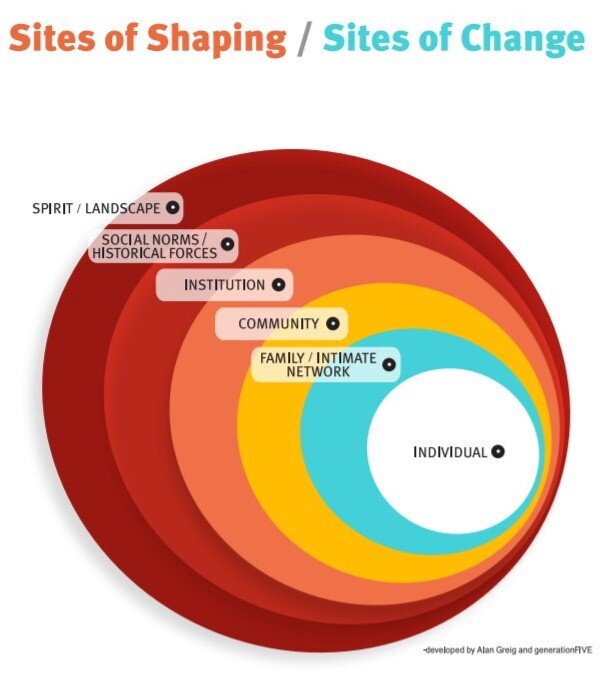Redefining Your Yardstick of Success
Take a moment and ask yourself, “How do I measure success?”
See if you can recall a time you’ve had that feeling that you’re really crushing it in life. What were you observing that was signaling this feeling was true?
For many of us, the everyday moments may be an empty inbox, a completed to-do list, getting a promotion or raise, or maybe a proud moment with your child.
We compare our lives constantly to an invisible “yardstick of success”, praising or scolding ourselves based on this measurement. But how often do we stop and question if we are using the right yardstick?
Staci Haines of the Strozzi Institute teaches a concept called “sites of shaping” to help us understand the different ways our beliefs, views on life and ways of being are shaped by different aspects of our lives.
As you scan through the layers above notice the impact each “site” has had on how you measure success.
Many of us inherited our first yardstick of success from our parents. In many ways, it may still be the same yardstick by which you measure your self today.
Decisions such as where you went to school, what you studied, what jobs you took, or who you married may have been (or still are) influenced by their yardstick. Think about how many of these decisions were measured against your parents’ yardstick of success.
Now layer in your teachers, societal norms, and your community expectations. You can see how quickly we end up with a yardstick that’s really measuring success by other’s standards, and we may never stop to question if this is truly a measure of what YOU consider success.
In his book Transitions (which you’ll hear me quote frequently), William Bridges describes the life transition that happens around 40, where “We transition from being motivated by the chance to demonstrate competence, to being motivated by the chance to find personal meaning in the work and its results.”
Have you ever worked really hard to achieve something, believing that as soon as you have accomplished that thing, you’ll be fulfilled? But then you get there, and it doesn’t feel any different? It’s likely you’re using an old yardstick. You are chasing something you may have previously defined as success, but now just doesn’t seem to align with what is truly important to you anymore.
Transitions like this call for a whole new yardstick of success. The pattern I see with many clients is that while they have internally shifted their motivation, they are still measuring themselves externally with an old yardstick.
So how do you create your new yardstick of success?
Step 1: Get clear on your definition of success
Let’s go back and reflect on the question we opened with: What does it mean to YOU to be successful in your life?
When you look back from your deathbed, how will you define a life well lived? What memories or experiences will make the highlight reel? What is TRULY important to you?
Take a moment and jot down some notes of what’s coming up for you. Go ahead, grab a pen, I’ll wait.
Step 2: Identify Your Values
Now look for what values are represented in your list. Perhaps family, connection, or relationships? Adventure, travel, or learning? Maybe impact or serving others?
Whatever it is for you, these are the elements of your new yardstick of success.
Go ahead, jot those down too.
Step 3: Surface the Indicators
What would it look like if you were really, truly living into those values you just identified? Imagine a life so aligned that if you pulled out that new yardstick, would it light up and shoot lasers because you were truly living your best version of a life well lived. What would it look like? How would it manifest in you daily life?
What would you be experiencing more of? Less of? What are some indicators that you are on or off course?
Here are a few of my indicators, to give you some examples (remember, this is a judgement free zone):
Health - no Crohn’s flares.
Regularly having meaningful moments with people I love.
Learning - I’m holding full conversations in Spanish, reading at least one book a month.
Dance parties had.
Time in nature - extra points when I get to sleep or pee outside ;)
Enough resources to help others when they need it. I measure this in moments of showing up for others with generosity.
Step 4: Ditch the Old Yardstick
Now for the fun part. Get out your paper and markers. Bring out your old yardstick, representing it however feels right to you. Thank it for its service. And then - retire it. That may mean ripping it up or burning it or putting it in a box or drawer. Whatever feels symbolically like retirement to you, do it. You know I love a good ritual!
Now for the extra fun part. Create your new yardstick. Maybe it starts to look like a vision board, maybe it looks like a habit tracker, or whatever wants to come out. Have fun with it, get creative.
Step 5: Start Realigning
Lastly, it’s time to start redirecting your energy. Where do you need to stop spending energy because it’s driven by the old yardstick? Where can you start shifting your energy into the activities that make that new yardstick light up and whir?
To start, pick 3 actions, commit, and see what happens.
Found this useful or inspiring? Interested in working together?



